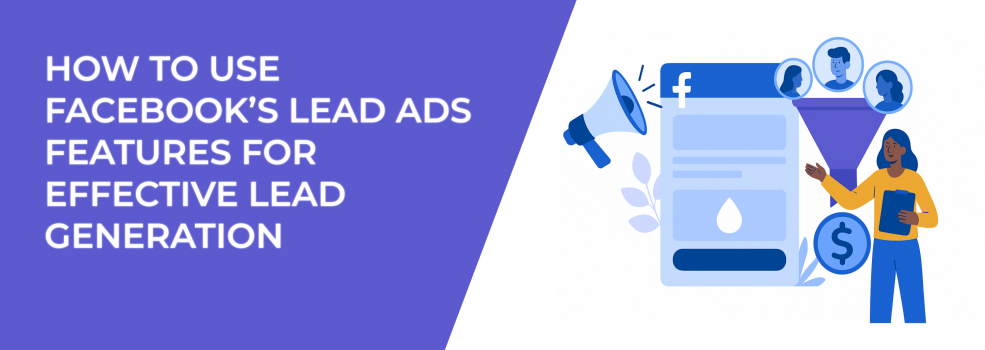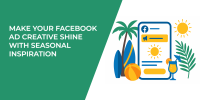Lead generation has always been the lifeblood of digital advertising, and Facebook’s lead ads remain one of the most powerful tools for capturing potential customers directly where they scroll. But while many advertisers are still relying on the classic setup, Meta has quietly transformed the landscape with its Advantage+ leads campaigns, making the process smarter, faster, and more efficient.
So what’s the catch? And are you using these tools to their full potential?
Let’s unpack how you can make the most of Facebook’s Lead Ads — both the traditional features and the newer, AI-powered Advantage+ campaign setup — to fuel better lead generation without wasting time or budget.
What makes Facebook Lead Ads so effective?
Before diving into the newer AI-driven tools, it’s worth remembering why lead ads on Facebook (and Instagram) are so effective to begin with.
They’re native — the user never has to leave the platform. That means less friction, more convenience, and higher conversion rates. Whether it’s filling out an instant form, starting a conversation via Messenger, or clicking to call, users can engage in a few taps.
More importantly, lead ads are versatile. You can use them to:
-
Collect emails for a newsletter.
-
Offer a downloadable guide or coupon.
-
Qualify leads with custom form questions.
-
Get potential clients to schedule a call or appointment.
The form-fill is smooth. The targeting is strong. And the ability to integrate directly with your CRM means you’re not just collecting data — you’re putting it to work.
But here's the part many advertisers miss: setting everything up manually each time slows you down. That’s where Advantage+ changes the game.
Advantage+ Leads Campaigns: AI efficiency without losing control
If traditional lead ads give you the tools, Advantage+ leads campaigns take those tools and sharpen them with AI.
These campaigns are designed to maximize performance while reducing setup time. Instead of spending hours refining your audiences, budget allocations, and placements, Facebook’s AI does all the basic things — automatically optimizing where your ads go, who sees them, and how much to spend.
It might sound like letting go of control, but that’s not entirely the case. Advantage+ campaigns give you:
-
Advantage+ budget — optimization at the campaign level to shift spend toward the best-performing ad sets.
-
Advantage+ audience — dynamic audience targeting based on signals like pixel activity, past engagement, and lookalike data.
-
Advantage+ placements — automatic delivery across Facebook, Instagram, Stories, Marketplace, and more, based on performance.
You still have the option to adjust or turn off these automations — but when left on, early data shows some impressive results: 14% lower cost per lead, and 10% lower cost per qualified lead, compared to campaigns built manually.
Curious how that plays out in real scenarios?
Imagine you're running ads for a service business — say, a financial consulting firm. Instead of creating multiple ad sets for different regions, you launch an Advantage+ leads campaign with a broad audience and a single goal: collect qualified leads. The AI tests different placements, regions, and behaviors in real time. It shifts spend automatically. You see which combos are converting and the system optimizes accordingly.
Want more proven tactics? Don’t miss our full guide on mastering lead generation in 2025.
Choosing the right Lead Ad format
One overlooked strength of Facebook Lead Ads is their format flexibility. Depending on your business goal, you can choose from several lead collection methods:
1. Instant Form
This is the classic setup. A pre-filled form pops up right after a user clicks the ad. You can include custom questions to qualify leads or segment them by interest. Want to know their budget range? Preferred service date? It’s all possible.
2. Click to Message
Instead of a form, users are taken straight into a conversation — via Messenger, Instagram Direct, or WhatsApp. This is great for businesses that want to engage leads instantly, answer questions, or use chat-based qualification flows.
3. Call Ads
Sometimes the fastest way to close a lead is to talk. Call-based lead ads prompt users to make a phone call directly from the ad, making them perfect for urgent services or time-sensitive offers.
Choosing the right format isn’t just about preference — it’s about knowing your audience and how they like to interact. For example, younger users may lean into chat, while older demographics might respond better to phone calls or forms.
And remember: Advantage+ doesn’t limit you to one format. You can still use any of these approaches within an AI-optimized campaign.
Not sure who your ideal lead is? This step-by-step guide to defining a target audience can help you sharpen your strategy before your ad even goes live.
Want better results? Use CRM data and the Conversions API
Many advertisers stop at collecting leads. But what happens next?
If you want quality leads, not just quantity, you’ll want to hook up your CRM and consider using the Conversions API. This setup allows you to feed conversion data (like purchases or qualified consults) back to Meta, improving ad delivery based on real outcomes.
According to Meta’s internal studies, advertisers who used this setup saw:
-
15% lower cost per quality lead,
-
44% higher lead-to-quality conversion rate.
That’s a serious boost, especially when you’re running campaigns at scale.
You can also upload high-value customer lists to create lookalike audiences, letting Meta find similar users likely to convert. Even small advertisers can benefit — if you’ve had just a few dozen strong leads, that’s enough to start training the system.
Fine-tuning while letting AI work
Just because Advantage+ automates many aspects doesn’t mean you should set it and forget it.
Want to exclude specific audiences? You can.
Prefer to control placements manually? Go for it — just know this will disable Advantage+ optimization.
The real trick is to start broad, monitor often, and gradually apply precision. Let the AI test, then refine based on real data. If performance dips or lead quality drops, use optional controls to course-correct.
Facebook even shows you whether Advantage+ is "on" or "off" at different levels of the campaign setup, so you’re never flying blind. If you’re still struggling with results, this guide on why Facebook ads don’t convert is worth a read before blaming your targeting.
Final thoughts
If you’re serious about lead generation on Facebook or Instagram and you’re tired of wrestling with endless targeting setups and form testing, then Advantage+ leads campaigns are absolutely worth trying.
They give you a powerful balance: automation when you need speed, flexibility when you want control.
But they’re not magic. The real success comes from knowing your audience, choosing the right lead ad formats, asking smart questions in your forms, and feeding your system good data from your CRM.
Lead generation isn’t just about volume — it’s about relevance, intent, and efficiency. And with Facebook’s latest tools, advertisers of all sizes can compete on that level.
So go ahead: take a second look at your lead ads strategy. Are you making the most of what Meta has to offer?

